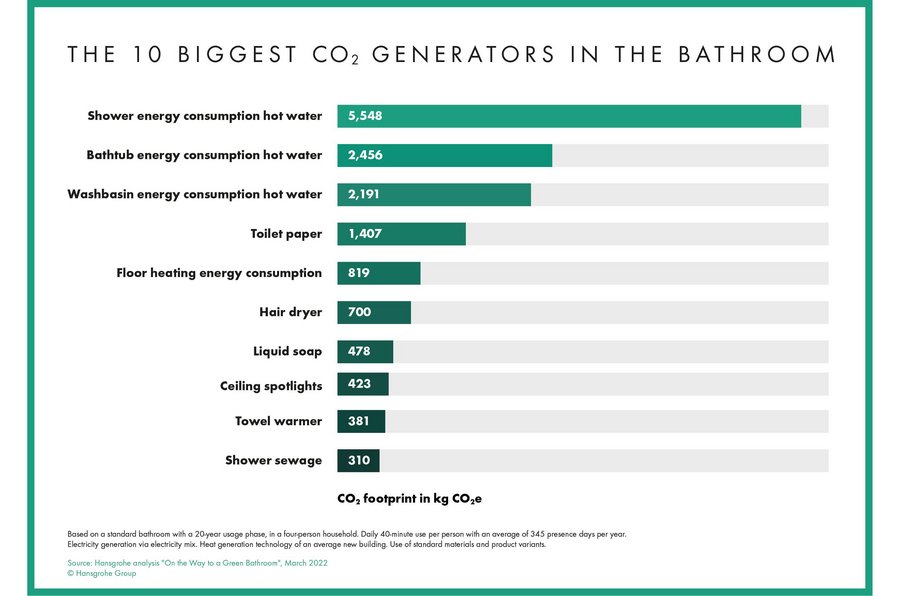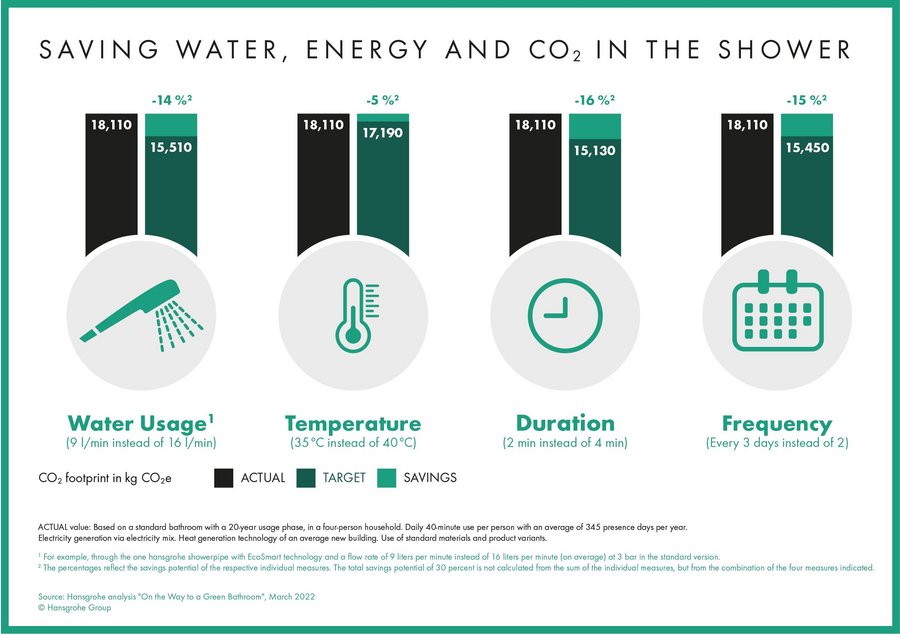Hansgrohe examines CO2 footprint of the bathroom

How much climate-damaging CO2 causes an average bathroom during
its construction and usage phases - from shower heads to ceramic products, to
toilet paper? How much climate
protection potential is there in an average German bathroom? That's what the
initiators of the Hansgrohe Bathroom Study 2022 asked themselves. The data
behind the accompanying Hansgrohe bathroom study provides insightful insights
and fact-based what-if scenarios for future bathroom design and use: How
specifically can the carbon footprint of a bathroom be positively influenced?
Hansgrohe
sheds light on the CO2 emissions generated during the construction and disposal
phases, as well as in a 20-year usage phase of a bathroom. The key finding of
the underlying analysis: 90 percent of CO2 emissions are attributable to the
usage phase of a bathroom.
This result
is incorporated into the future orientation of the product portfolio of the two
brands Axor and Hansgrohe in the faucets and showers segments. "By 2030,
we want to convert our entire water-using product portfolio to water and
energy-saving technologies. In the future, they must be part of every
energy-efficient renovation and new construction. We engage wherever we can
jointly adjust emissions-relevant screws in the bathroom and kitchen
sector," says Hans Juergen Kalmbach, Chairman of the Executive Board,
Hansgrohe SE.
Hansgrohe
sees itself as a manufacturer with direct responsibility. "Back in 1987,
we introduced our first water-saving product with the Mistral Eco hand-held
shower. But private households also bear responsibility by realizing and
consciously dealing with their role as hot water consumers and CO2
emitters," says Steffen Erath, Head of Innovation & Sustainability,
Hansgrohe SE.
Even a Few Measures Advance Climate Protection

The figures
show the savings that are possible: Just using a water-saving shower system
consisting of an overhead and a hand-held shower* can save around 14 percent
CO2 over the entire usage phase. Innovative technologies such as these not only
reduce the flow of water while maintaining showering comfort, but they also cut
hot-water-related energy consumption. The current consumer campaign "80
million together for energy change" of the German Federal Ministry of
Economics and Climate Protection also points to the energy-saving potential of
water-saving showers.
At the same
time, a four-person household can reduce its personal CO2 footprint by a total
of 30 percent from 18,110 kilograms to 12,680 kilograms over the 20-year usage
phase, including production and disposal, by adjusting its showering habits.
This corresponds to a saving of 22,630 kWh of energy in hot water production.
Such a reduction can be achieved by, in addition to using a water-saving shower
system, lowering the shower temperature from 40 degrees Celsius to 35 degrees
(five percent), reducing the shower duration from four to two minutes (16
percent) and showering only every third day instead of every second (15
percent)**. If similar measures are also taken for the bathtub and washbasin***,
the CO2 footprint can be reduced by as much as 44 percent, from 18,110
kilograms of CO2 to 10,180 kilograms of CO2. In total, 33,890 kWh of energy can
be saved in hot water production.
Basis: Analysis "On the Way to a Green Bathroom“
The figures
are the result of a scientific analysis by Timo Armbruster (M. Sc.), which he
provided for Hansgrohe at the Faculty of Business and Law at Pforzheim University.
The calculations relate to a four-person household and consider not only water
consumption, but also the bathroom interior and consumables such as toilet
paper, toothpaste, liquid soap, deodorant or trash bags. Even the weekly
bathroom cleaning and the semi-annual change of the toilet brush are included
in the figures. The emissions calculation assumes modern heat generation
technology in new buildings and an electricity mix of fossil and renewable
energy sources. Bathroom use amounts to 345 days of attendance per year, with a
daily bathroom time of 40 minutes per person per day.
These levers positively influence CO2 emissions
Three
central levers for positively influencing CO2 emissions in the bathroom are
relevant. Users who shower less frequently, for shorter periods and with lesser
heat, and who use water-saving shower heads, help protect the environment. For
their part, manufacturers can use technical innovations to reduce the flow of
water in shower heads and offer energy-saving faucet models - such as
Hansgrohe's CoolStart technology, among others: Here, the water flow starts
with cold water instead of preheated water. A third option: heating water with
alternative CO2-neutral energy (solar thermal).
"Everything
we do has an impact on the climate. We must be aware of that, each of us.
Ideally, however, acting responsibly does not mean foregoing shower comfort,
for example," says Steffen Erath. "We're driving our shower and
faucet systems forward technologically so that less water per minute doesn't
mean less water experience for the user."
* For
example, through a hansgrohe showerpipe with EcoSmart technology and a flow
rate of 9 liters per minute instead of 16 liters per minute (on average) at 3
bars in the standard version.
** The
percentages in parentheses indicate the savings potential of the individual
measures. The total savings potential of 30 percent is not calculated from the
sum of the individual measures, but from the combination of the four measures
indicated. Source: Hansgrohe analysis "On the Way to a Green
Bathroom".
*** Bathtub:
frequency - every 28 instead of every 14 days, temperature - from 40 degrees
Celsius to 35 degrees Celsius, filling volume - from 170 l to 140 l. Washbasin:
hansgrohe faucet with CoolStart function, usage time from 195 s to 150 s,
alternatively hansgrohe low-flow faucet with a flow rate of 3.5 l/min instead
of CoolStart faucet: CO2 savings: 45 percent from 18,110 kg to 9,980 kg. Energy
saving: 34,610 kWh